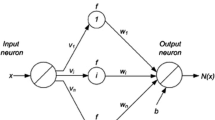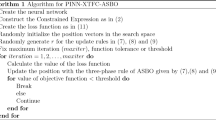Abstract
In this article, we have used the Legendre artificial neural network to find the solution of the Bagley–Torvik equation, which is a fractional-order ordinary differential equation. Caputo fractional derivative has been considered throughout the presented work to handle the fractional order differential equation. The training of optimal weights of the network has been carried out using a simulated annealing optimization technique. Here we have presented three examples to exhibit the precision and relevance of the proposed technique with comparison to the other numerical methods with error analysis. The proposed technique is an easy, highly efficient, and robust technique for finding the approximate solution of fractional-order ordinary differential equations.












Similar content being viewed by others
References
Khan NA, Shaikh A, Sultan F, Ara A (2017) Numerical simulation using artificial neural network on fraction differential equations, World’s largest Science, Technology & Medicine Open Access Book Publisher, (August), pp 97–112
Bansal MK, Jain R (2016) Analytic solution of Bagle–Torvik equation by generalize differential transform. Int J Pure Appl Math 110(2):265–273
Arora G, Devshali P (2017) Solution of the Bagley–Torvik equation by fractional DTM. In: AIP conference proceedings, vol. 1860, pp 1–6. https://doi.org/10.1063/1.4990331
Bagley RL, Torvik J (1983) Fractional calculus: a different approach to the analysis of viscoelastically damped structures. AIAA J 21(5):741–748
Torvik PJ, Bagley RL (1984) On the appearance of the fractional derivative in the behavior of real materials. J Appl Mech 51(2):294–298
Podlubny I (1998) Fractional differential equations. Academic Press, London
Diethelm K, Ford NJ (2002) Numerical solution of the Bagley–Torvik equation. Manch Centre Comput Math 42(3):490–507
Hu Y, Luo Y, Lu Z (2008) Analytical solution of the linear fractional differential equation by Adomian decomposition method. J Comput Appl Math 215:220–229
Castillo E, Cobo A, Gutierrez JM, Pruneda E (1999) Working with differential, functional and difference equations using functional networks. Appl Math Model 23:89–107
Tomasiello S (2009) A functional network to predict fresh and hardened properties of self-compacting concretes. Int J Numer Methods Biomed Eng 27:840–847
Erdem RT, Seker S, Ozturk AU, Gucuyen E (2013) Numerical analysis on corrosion resistance of mild steel structures. Eng Comput 29:529–533
Podlubny I, Skovranek T, Jara BMV (2009) Matrix approach to discretization of fractional derivatives and to solution of fractional differential equations and their systems. In: International conference on emerging technologies and factory automation (ETFA). IEEE, Mallorca, Spain, 22–25 Sept 2009
El-Sayed AMA, El-Kalla IL, Ziada EAA (2010) Analytical and numerical solutions of multi-term nonlinear fractional orders differential equations. Appl Numer Math 60:788–797
Kurnaz A, Cenesiz Y, Keskin Y (2010) The solution of the Bagley–Torvik equation with the generalized Taylor collocation method. J Frankl Inst 347(2):452–466
Raja MAZ, Khan JA, Qureshi IM (2011) Solution of fractional order system of Bagley–Torvik equation using evolutionary computational intelligence. Math Probl Eng 2011:1–18. https://doi.org/10.1155/2011/675075
Koker R (2013) A neuro-simulated annealing approach to the inverse kinematics solution of redundant robotic manipulators. Eng Comput 29:507–515
Loia V, Parente D, Pedrycz W, Tomasiello S (2018) A granular functional network with delay: some dynamical properties and application to the sign prediction in social networks. Neurocomputing 321:61–71
Tomasiello S, Macias-Diaz JE, Khastan A, Alijani Z (2019) New sinusoidal basis functions and a neural network approach to solve nonlinear Volterra–Fredholm integral equations. Neural Comput Appl 31:4865–4878
Verma A, Kumar M (2019) Numerical solution of Lane–Emden type equations using multilayer perceptron neural network method. Int J Appl Comput Math 141(5):1–14
Chakraverty S, Mall S (2013) Comparison of artificial neural network architecture in solving ordinary differential equations. Adv Artif Neural Syst. 2013:1–12. https://doi.org/10.1155/2013/181895
Mekkaoui T, Hammouch Z (2012) Approximate analytical solutions to the Bagley–Torvik equation by the fractional iteration method. Ann Univ Craiova Math Comput Sci Ser 39(2):251–256
Mohammadi F (2014) Numerical solution of Bagley–Torvik equation using Chebyshev wavelet operational matrix of fractional derivative. Int J Adv Appl Math Mech 2(1):83–91
Labecca W, Guimaraes O, Piqueira JRC (2015) Analytical solution of general Bagley–Torvik equation. Math Probl Eng 3:1–4
Popolizio M (2018) Numerical solution of multiterm fractional differential equations using the matrix Mittag–Leffler functions. Mathematics 6(1):1–13
Pang D, Jiang W, Du J, Ullah A, Niazi K (2019) Analytical solution of the generalized Bagley–Torvik equation. Adv Differ Equ 8:1–13
Caputo M (1967) Linear models of dissipation whose Q is almost. Geophys J R Astron Soc 13:529–539
Chakraverty S, Mall S (2014) Chebyshev neural network based model for solving Lane–Emden type equations. Appl Math Comput 247:100–114
Chakraverty S, Mall S (2020) Single layer Chebyshev neural network model with regression-based weights for solving nonlinear ordinary differential equations. Evol Intell. https://doi.org/10.1007/s12065-020-00383-y
Raja MAZ, Samar R, Manzar MA, Shah SM (2017) Design of unsupervised fractional neural network model optimized with interior-point algorithm for solving Bagley–Torvik equation. Math Comput Simul 132:139–158
Pedas A, Tamme E (2011) On the convergence of spline collocation methods for solving fractional differential equations. J Comput Appl Math 235:3502–3514
Acknowledgements
The authors are grateful to the National Board of Higher Mathematics (NBHM), Government of India for providing financial support to carry out this work through its Project sanctioned Order No. 02011/25/2019/R&D/7351. We express our sincere thanks to editor in chief, editor and reviewers for their valuable suggestions to revised this manuscript.
Author information
Authors and Affiliations
Corresponding author
Additional information
Publisher's Note
Springer Nature remains neutral with regard to jurisdictional claims in published maps and institutional affiliations.
Rights and permissions
About this article
Cite this article
Verma, A., Kumar, M. Numerical solution of Bagley–Torvik equations using Legendre artificial neural network method. Evol. Intel. 14, 2027–2037 (2021). https://doi.org/10.1007/s12065-020-00481-x
Received:
Revised:
Accepted:
Published:
Issue Date:
DOI: https://doi.org/10.1007/s12065-020-00481-x
Keywords
- Fractional differential equation
- Caputo fractional derivative
- Legendre polynomial
- Simulated annealing optimization technique




